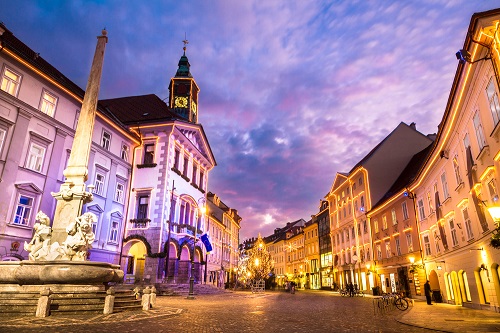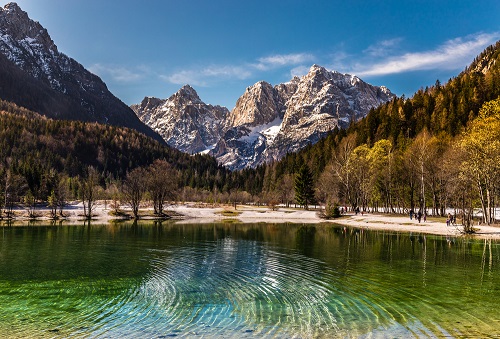The Republic of Slovenia’s healthcare system ranked 21st in 2018’s European Health Consumer Index (EHCI), behind Switzerland, France and the UK, but ahead of the Republic of Ireland, Greece and Croatia. Although its position has slipped in recent years (in 2015, the country placed 15th), life expectancy has risen to higher than the EU average.
Health insurance in Slovenia
Slovenia operates a compulsory national health insurance scheme, called the Zavod za zdravstveno zavarovanje Slovenije (ZZZS) or Health Insurance Institute of Slovenia (HIIS). Employees contribute 6.36% of their wages, and employers contribute 7.09%, into this scheme. Retired Slovenians contribute 5.96% of their pensions, and self-employed residents should register to make contributions. Children, students, pregnant women, people who are unemployed and those who receive benefits are automatically covered.
If you are relocating to Slovenia when retired or self-employed, you will need to complete an S1 form to ensure health insurance coverage, as this will not be automatically taken care of by an employer.

The HIIS plan covers most standard healthcare needs, for instance GP visits, prescriptions, and state hospital visits, but you will need to pay between 5% and 90% of the fee as a co-payment if you only have a HIIS plan. Emergency care is free for everyone in Slovenia, so you will not incur any co-payment fees in the event of an emergency. The table below summarises the co-payments required for different types of care, and full information can be found on the HIIS/ZZZS website.
| Medical services to which additional payments apply | Additional payments |
Transplantations of organs, most demanding surgical operations irrespective of the reason for them, intensive therapy, dialysis, and other most demanding therapeutic and rehabilitation services | 10 % |
Medical services in the field of specialist outpatient and inpatient activities; services in the field of health resort treatment as the continuation of hospital treatment, with the exception of injuries that were not caused at work; services in the field of dental and oral cavity treatment; orthopaedic, orthotic, hearing and other medical appliances | 20 % |
Specialist outpatient, inpatient and health resort services as continuation of hospital treatment, and the non-medical part of nursing in a hospital or health resort as continuation of hospital treatment, as well as orthopaedic, orthotic and other appliances related to the treatment of injuries that were not caused at work | 30 % |
Medical services of health resort treatment and non-medical nursing within health resort treatment (the hotel part of the hospitalisation) that is not a continuation of hospital treatment | 90 % |
Dental prosthetic treatment of adults, ophthalmic appliances for adults | 90 % |
Medical products from positive list | 0-30 % |
Medical products from interim list | 90 % |
Medical products from negative list | 100 % |
Ambulance transport that is not urgent | 90 % |
You must register as a resident once you have lived in Slovenia for three months, and once you are registered you are entitled to HIIS cover. If you choose to wait to register as a resident until then, you will need to make sure you have the right travel insurance in place. If you have a European Health Insurance Card (EHIC), you will automatically be covered. However, if you are from the UK and moving to Slovenia from 1 January 2021 onwards, bear in mind that your EHIC will not necessarily cover you post-Brexit. Therefore, you will need to make sure that you have the correct coverage in place before you move.
Optional add-ons
Private health insurance in Slovenia takes the form of voluntary/supplementary health insurance (VHI). Voluntary health insurance is designed to cover the co-payments necessary with HIIS. This is offered by three providers: Vzajemna, Triglav and Generali. Their websites are in Slovene, so make sure that you have assistance from someone who can speak the language if you wish to apply for coverage online. Although prices vary slightly between the three providers, monthly premiums are between €30 and €40. By law, they are the same for all policyholders. Students, children, unemployed people, people receiving benefits and pregnant women are automatically covered by VHI, in the same way as they are covered by HIIS.
Having HIIS and supplementary health insurance will ensure that you aren’t paying out of pocket for a wide range of healthcare. However, there may still be areas where you need more cover. For instance, you may require cover for dental procedures, extra maternity services, or pre-existing conditions. For these, you may opt to take out a private plan with an international provider, such as Cigna Global or BUPA.

As well as VHI, Vzajemna, Triglav and Generali offer dental, specialist and accident insurance policies and family plans. The main benefit of specialist insurance is to reduce waiting times, as the shortage of specialists in Slovenia can mean a long wait even after you have received your referral.
Dental and accident insurance policies may work out as the most cost-effective options for you, especially if there is a family plan that suits you and your dependants’ needs. If you are single and do not expect a lot of out-of-pocket healthcare expenses, you may not find even VHI necessary and could choose to keep your costs low by sticking with only HIIS. However, a VHI plan is strongly recommended.
Prescription costs
The cost of prescriptions can easily add up, especially if you have several conditions and/or several dependants requiring medication. The HIIS categorises medications into positive, intermediate/interim and negative. For positive medications, co-payments are 0-30%. For intermediate, they are 75-90%, and for negative, the patient is liable for the full cost of the medication.
HIIS also sets the Highest Recognised Value (HRV) of each medication, and any cost over this must be covered by the patient or patient’s VHI. However, those with long-term conditions or chronic illnesses are eligible for free prescriptions, as are pregnant women, children, students and people who are unemployed or on a low income.
The Central Medicines Database contains information on all medications covered by HIIS, as well as what the co-payments/surcharges are for others. Groups of ‘mutually interchangeable’ drugs are defined by the Office of the Republic of Slovenia for Medical Products as: medicines containing the same active ingredients that can be interchanged to keep costs low. The groups include medication for diabetes, cardiovascular disease, skin diseases and allergies, and contraception.
Slovenia generally has a great level of healthcare coverage under the compulsory HIIS scheme, and it may be tempting not to get voluntary health insurance, in order to save money. However, when you consider that you could be liable for 90% of the fee of your treatment, it is strongly recommended that you invest in a VHI plan. It will help give you peace of mind.

